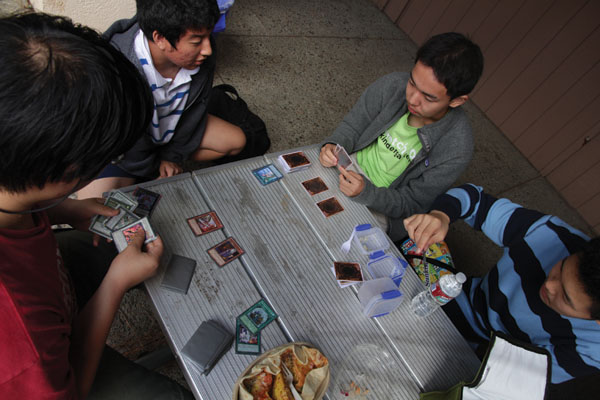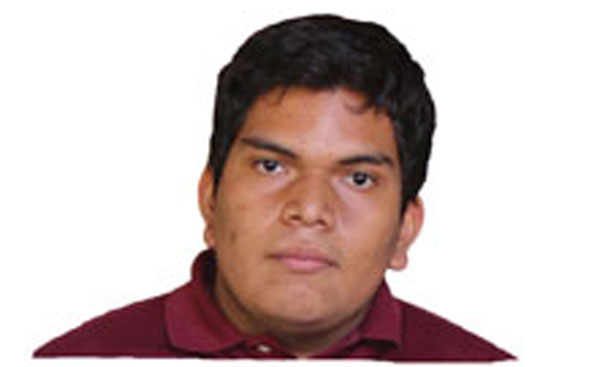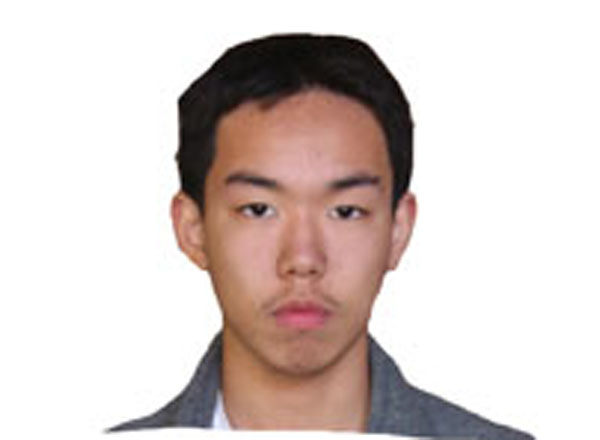
The sound of the lunch bell reverberates throughout the campus, calling duelers from all corners of the school to the field of battle. Already, Yu-Gi-Oh players have started to gather around the metal picnic tables in between the math building and the library. On a concrete ledge, Palo Alto High School junior Peter Nishimura and sophomore Christopher Cerpa sit facing each other, eyes locked on the cards laid out before them.
“I’m just saying, man, it is a pretty good card,” Cerpa says.
Nishimura nods his head in agreement, playing his own monster to counter Cerpa’s.
The game pits two players and their decks of Yu-Gi-Oh cards against one another. Each starts with five cards in their hand, drawing one each turn. By playing the cards and following the descriptions on each one, they can inflict damage on each other’s life points. Once one player loses all 8,000 of their life points, their opponent is declared the winner.
As the crowd around the two players grows, so does the pile of discarded lunch containers, hastily emptied of their contents in the excitement of the duel.
Behind the tables, juniors Cooper Ganschow and Jacob Mucciaroni pace excitedly, discussing everything from girlfriends to their favorite card games, their speech punctuated with shouts and fits of laughter. A swift breeze blowing through the overhang catches the corners of cards, sending them spinning away from their respective battles.
On the concrete ledge, Cerpa curses as Nishimura destroys one of his monsters. Rapidly moving his arms, Nishimura sends a merciless wave of attackers Cerpa’s way. Cerpa shifts his hands, nervously surveying the beleaguered state of his troops.
“I need a miracle here,” Cerpa says.
His prayer is not answered. Nishimura finishes him off, finally breaking his focus and letting out a smile.
This is a typical scene for the unofficial Yu-Gi-Oh club that meets daily at lunch for some friendly dueling.
“It’s just fun and relaxing to play during lunch and stuff and to just get a break,” junior Shelton Cai says.
Although Cai lost interest in Yu-Gi-Oh during elementary school, he picked it up again in eighth grade. Along with Nishimura, he started playing regularly, eventually bringing more friends into the group.
“When we started, it was mostly just us two playing, and then it eventually grew to about ten people,” Cai says.
Although originally devoted to Yu-Gi-Oh, the group has expanded to other games as more people have joined.
“There’s Magic the Gathering, Dungeons and Dragons, and a bunch of other games which people try once in a while,” Cai says.
As Cai speaks, a game of Magic the Gathering commences behind him. Similarly to Yu-Gi-Oh, the game involves the use of monsters and magic to attack one’s opponent. Senior Brian Santa Gadea simultaneously challenges two opponents.
“You get a close bond playing in person,” Santa Gadea says.
The variety of different card games seems to provide something for everyone, even the spectators, a feature which has allowed the group to expand to include new members.
“My friends hang out here so now I’m here,” sophomore Gregory Syssoyev says.
Syssoyev glances back at the concrete ledge. In Cerpa’s spot, Cai is sitting down to challenge Nishimura.
“Okay, Peter, bring it on,” Cai says.
From the metal tables, junior Philip Green engages Nishimura in a Pokémon discussion.
“How would you level up this one?” Nishimura says, showing Green a Pokémon card.
“Probably by dancing around a magical fairy shoe,” Green says with a laugh.
Nishimura turns to talk to Green, momentarily taking his focus away from the game. Cai capitalizes on the distraction, killing several of Nishimura’s monsters.
“Gotcha,” Cai says.
A smile across his face, Cai gleefully reminds Nishimura how the game is going.
“You’re down to 1,000 [life points],” Cai says.
Nishimura mounts a final rally, attacking Cai with as many monsters as he can. However, the effort falls short and Cai is able to defeat Nishimura on his next turn.
“You got owned!” Cai says, exuberantly slapping the cement battlefield.
Nishimura humbly accepts his defeat. Cai’s victory is acknowledged by a shout of “God bless America” from Ganschow and Mucciaroni.
Brought together by their common interest in Yu-Gi-Oh, the group has blossomed into a close-knit community.
“I’ve met a lot of new people,” Nishimura says. “If not for Yu-Gi-Oh, we wouldn’t have any reason to talk to each other.”
By bringing the group of friends closer together, Yu-Gi-Oh has had an impact on their lives.
“I’m becoming more and more of a nerd,” Nishimura says. “I’d rather stay here than go to a [school] rally.”
“It keeps my insanity to a minimum,” Cerpa says.
The bell rings, signaling the end of battle for the day. Players scoop empty lunch containers off the tables, leaving only a few wrappers as evidence of the dueling that took place there moments before. As the cries of battle fade away, so does the mythical world of Yu-Gi-Oh, and the players pack their armies of paper monsters away into their cardboard boxes unil the next day.
Player Profiles
Brian Santa Gadea
(Senior)
Dueling origins: Began playing in elementary school, when his brother introduced him to Yu-Gi-Oh
Dueling time per week: 2 hours
Other: In addition to playing Yu-Gi-Oh at school, Brian duels online and has even participated in online tournaments
Peter Nishimura
(Junior)
Dueling origins: Began playing in elementary school
Dueling time per week: 2-3 hours
Yearly budget for cards: No more that $50
Other: Creator of Paly’s Yu-Gi-Oh community
Shelton Cai
(Junior)
Dueling time per week: 75 minutes
Yearly budget for cards: “I don’t spend as much as I did before, but back when I did it was a decent amount”
Other: Creator of Paly’s Yu-Gi-Oh community







